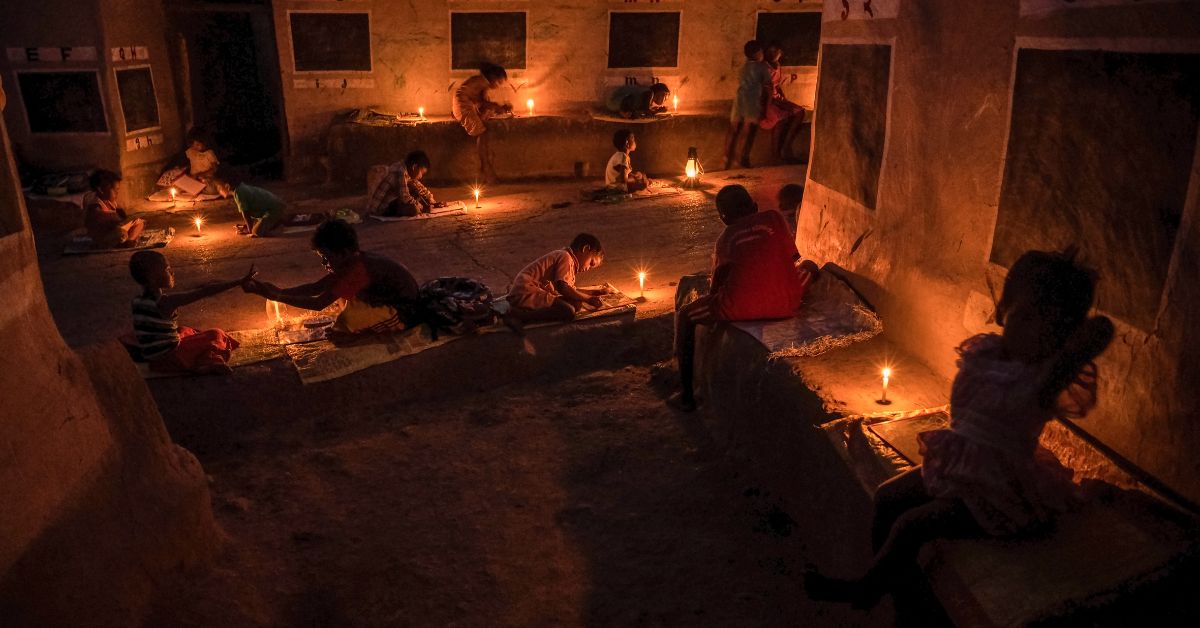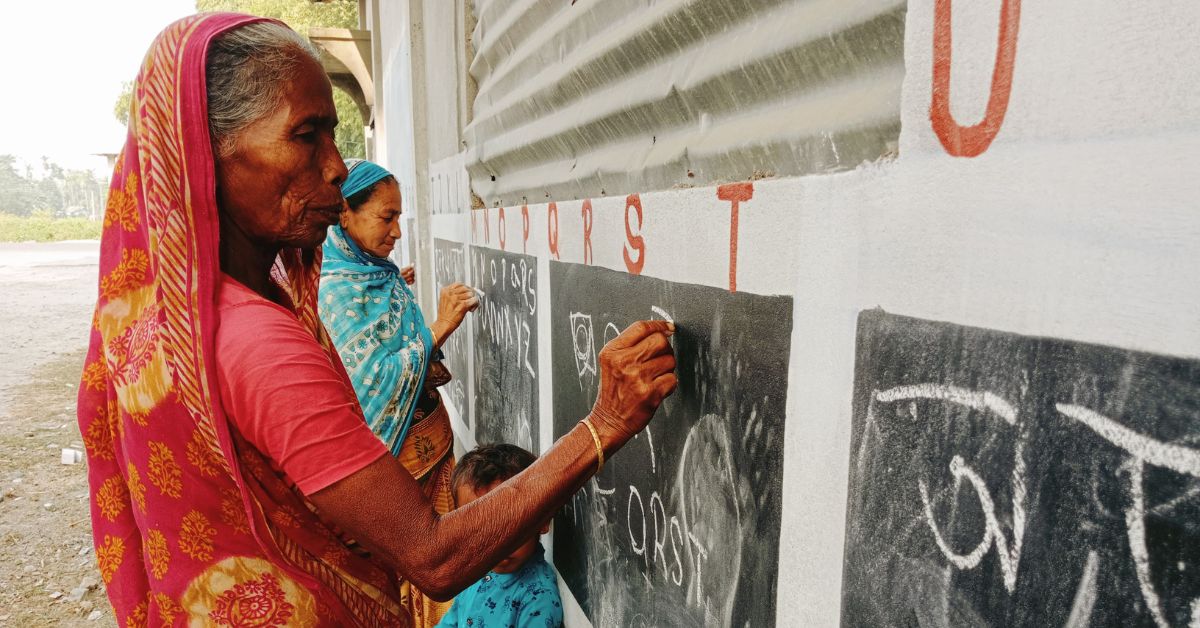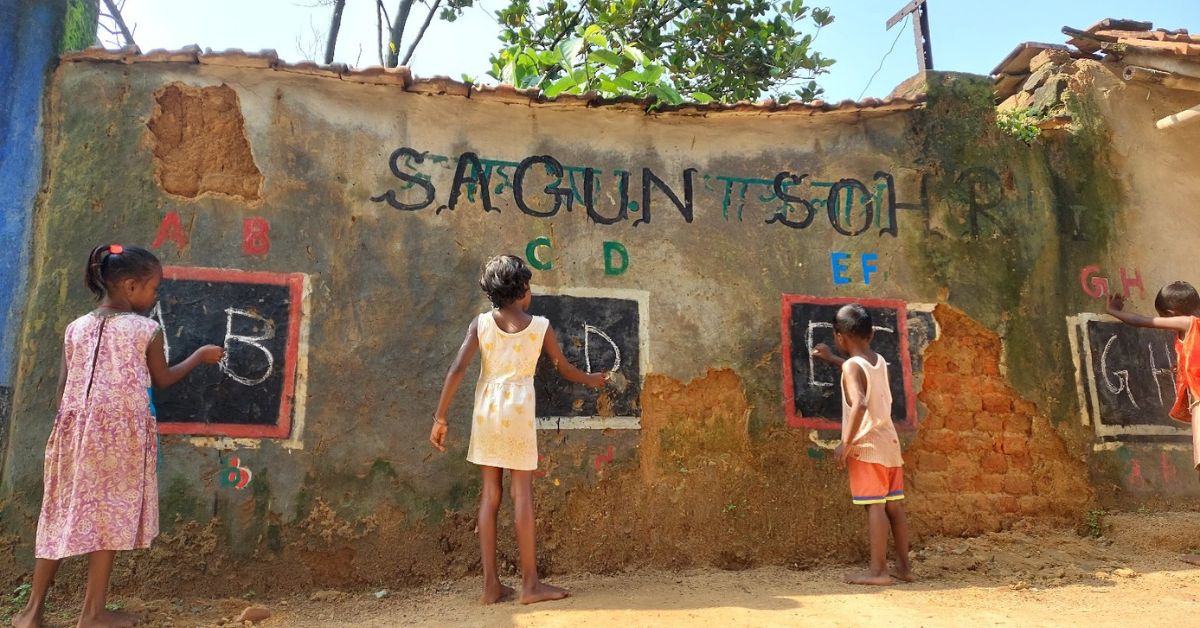This Hero Turned Mud Walls Into Blackboards & Streets Into Schools for 10,000 Children
Deep Narayan Nayak from West Bengal has converted walls of homes to blackboards and teaches three generations. He wants to break the cycle of poverty and his Raster Master model has impacted over 10,000 students.

Deep Narayan Nayak (37) grew up with limited means in a big family in Nandigaon village in Jamuria, Asansol, West Bengal. From the first day of school till the last, he never wore a new uniform or studied from a new book. Deep and his four older sisters managed with hand-me-downs and worn-out uniforms, which their mother would somehow patch up for them.
Such was his desire to study that he always kept the resources from affecting his academic performance. But as the five children grew up, their father’s income, derived from multiple jobs, was just not sufficient to feed the nine mouths (including his grandparents). While all the siblings attended school till Class 8, the financial constraints grew, causing his sisters to drop out of school.
As a boy, Deep managed to finish his education, earning a BSc in botany. Later, he had to stop studying but pursued teacher training and became a primary school teacher. Witnessing children facing similar struggles to his own childhood, he refused to stay silent. He was determined not to let other children, especially girls like his sisters, face the hardships he experienced.
Deep began by assisting two children in his school, providing them with new books, slates, and other essentials. This small act grew into a huge movement to educate underprivileged children and break the cycle of poverty. Starting in Jamuria district, it expanded to seven more districts in West Bengal, Jharkhand, and even Bangladesh, impacting over 10,000 students.
Called ‘Raster Master’ (teacher of the streets), Deep educates not just children, but also their parents and grandparents. His programmes are aimed at reducing dropouts, providing nutritious food, stopping child marriages, bridging the gender gap in education, empowering women, and changing mindsets.
Furthermore, he works on improving education and livelihoods through his Raster Master Research Centre and International Foundation.
Breaking the vicious cycle of poverty

Deep remembers his father working as a daily wage labourer in the morning, cleaning a medical shop after, and working as a watchman at night. In fact, the family stayed in the house where his father worked as the owners were out of the country.
“My father worked day and night for us. But after the house owner returned, we had to move out to a small clay house (kutia) away from the village where there was no electricity. So I would wake up at 3 am every day to study, and in the evenings, I studied on the street as it was well-lit,” says Deep.
He finished school without electricity at home.
After Class 10, his classmates moved to cities for higher education, but he couldn’t due to financial constraints. He considered quitting and working, like his sisters. So he began tutoring kids. But a gentleman saw his good scores and encouraged him to keep studying.
Despite a government school being available, few enrolled. Deep was among the three students there, and he was the only one who passed the Boards.
The well-wisher further lent him books with the condition to return the books within two years. “He was saving the book for his domestic help’s child, who was two years younger than me. He motivated me to study well and finish Class 12,” adds Deep.
Initially wanting to study chemistry, he changed his mind as he couldn’t afford the many books the course required. So he chose botany instead as it involved a lesser number of books. After starting college, he had no books for nearly three months. When the principal found out, he arranged for Deep to borrow them from the library for a year.
After finishing his degree, Deep became a primary teacher in 2010. On his first day at school, he felt a strange sense of deja vu, something he didn’t expect or desire.
“I saw children who came from backgrounds like mine — three to four siblings, no proper jobs for parents, and borrowing old books. These children were going through the same pain and struggle I did while growing up. I didn’t want to see another child face the same hassles as me to get a good education,” he adds.
He started buying new books and slates for two children at his school. The number slowly increased as other children also wanted these shiny books. Most of these children didn’t know what a new book or slate even looked like. While the ‘Raster Master’ tried to buy it for as many children as he could with his own money, he knew that it wasn’t something he could continue doing in the long run.
So he came up with a unique model that would be the first step to what would soon transform into a movement.
The 3G Model

Deep started turning the walls of children’s homes into blackboards, by painting them. This way, when children returned from school with homework, parents began learning too. He calls it the 3G model — teaching three generations in reverse. The child, often the first learner in the family, teaches parents and grandparents.
He started by converting the mud walls of the houses in the village into classroom walls, where he teaches. By painting small portions of the walls black, he created several blackboards open for learning right at the doorsteps of these children.
While parents were reluctant about sending their children to these classes, he started asking the children to teach their parents. Now, many mothers, fathers and grandparents have learnt enough to write a sentence or their own name. He says this method increases bonding, provides basic education to people regardless of age, and helps the older generation realise the importance of education.
His motto is, “Where there is a wall, there is a way,”

“When I began teaching kids, I noticed that their education often stopped around Class 10. Boys would start working, and girls would either get married or work as well. The 3G model helps to prevent this. It makes parents aware of what they missed and emphasises the importance of education,” says Deep.
Surojit, a student of Deep’s for over seven years, mentions that all the kids eagerly await Deep’s visits to their Bankura village. Surojit, now 20 and studying engineering, credits Deep for his significant support. His father does odd jobs, and Surojit will be the first engineer from their village. “We all wait for the Master’s arrival, especially the younger kids. He also gets food for us, which the children, who otherwise eat mid-day meals, enjoy very much,” he says.
Thanks to Deep’s efforts, numerous kids are now pursuing various degrees like engineering, nursing, arts, and more, outside their villages and even beyond the state. The teacher feels immensely proud, sharing stories from a student studying psychology at Delhi University to another securing a government job, among many others.
“Earlier, a child would go out of the village only as a labourer or after getting married (with respect to girls). Now, they have the liberty to dream and pursue an education of their choice,” he shares.
Shalini from Sukhbazar in Howrah is the first from her village to go to Delhi to study. She was sure that she wanted to pursue a degree in psychology and worked towards it. While most girls in her school got married during school or after Class 12, Shalini took Deep’s help to convince her parents to pursue her education.
“Everyone in our village wants to get girls married early. They feel that a girl should go out of the village only to her husband’s house. It’s because of Deep Sir that I was able to pursue my psychology honours at Delhi University,” says Shalini.
Starting in Jamuria, Deep’s initiative gradually expanded to other districts in West Bengal and Jharkhand. He now has a team that trains other teachers as they have students from age 5-50.
“One has to teach in a way that matches how each age group learns. We have a team of 150, which consists of 50 teachers and 100 associates. After training, the associates become teachers. We go to each village and choose teachers from there as they are best equipped to teach the children,” he adds.
The ‘Raster Master’ education model is almost a zero investment system with great returns. The teacher says that it costs Rs 100 to convert a street into a classroom. It helps bridge the digital divide for students who can’t afford phones, don’t have internet and have patchy electricity.
Each child is taught five languages — Bengali, English, Hindi, Urdu and Ol Chiki — through the 5L (language) model. They can read, speak and write in all the languages.
Deep himself is on the streets from 8 am to 8 pm to teach the children. He continues his Government teacher job and takes classes before and after school.
He also provides nutritious food to children as he doesn’t want them to be a victim of malnutrition. He pays for all this from his pocket, exhausting all his savings and salary for the cause.
‘I feel guilty about my sisters dropping out’

When Deep was young, he didn’t notice he was the only one encouraged to study, owing to his male gender. As he grew up, he noticed girls still face barriers in education today. This inspired him to make it his mission to support girls and talk to their families about giving them better education opportunities.
“Even today, people are not happy when a girl is born. Even though sex determination tests are illegal in India, people still find a way to find out and abort the baby. I want to ensure that every child, especially girls, get a good education,” he says.
Deep began visiting hospitals and homes whenever a girl was born to encourage parents to celebrate her arrival. He gifts sweets and gives them 10 saplings, which grow into valuable trees over 20 years that can be sold for a good price. “I give trees like mahogany which sell for about Rs 1 lakh per tree once grown, which takes roughly 10 years. I tell them to water these trees carefully which would tomorrow become an asset for them,” adds the teacher.
He believes caring for the trees is like nurturing your dreams. Initially, people didn’t trust him, but as they saw trees growing in various homes, their trust grew in the Raster Master. To inspire parents to educate their girls, he brings back former students from the village who are now successful engineers and graduates.
“Earlier, I would bring big officers to give inspirational talks, but that didn’t work. When a girl whom they’ve seen since childhood comes with a degree, parents connect more, as they come from the same background,” he adds. He shows them real-life heroes who they can connect with and relate to, which makes them feel that these dreams are within reach.
His goal now, he says, is to spread his centres worldwide and make education accessible to all. “I don’t want anyone to go through what my sisters did. I will ensure that every girl and every boy gets an education,” he says.
He was selected among the Top 10 teachers for the 2023 Global Teacher Prize, presented by the Varkey Foundation in partnership with UNESCO.
Deep now needs more funding to expand his model and provide more resources for students. If you wish to help, you can contribute to:
Raster Master International Foundation
A/C No – 40715717111
IFSC – SBIN0006188
Branch – Jamuria Bazar
(Edited by Pranita Bhat and Padmashree Pande)
If you found our stories insightful, informative, or even just enjoyable, we invite you to consider making a voluntary payment to support the work we do at The Better India. Your contribution helps us continue producing quality content that educates, inspires, and drives positive change. Choose one of the payment options below for your contribution- By paying for the stories you value, you directly contribute to sustaining our efforts focused on making a difference in the world. Together, let’s ensure that impactful stories continue to be told and shared, enriching lives and communities alike. Thank you for your support. Here are some frequently asked questions you might find helpful to know why you are contributing?

This story made me
- 97
- 121
- 89
- 167















